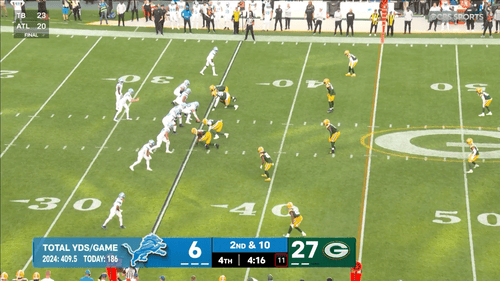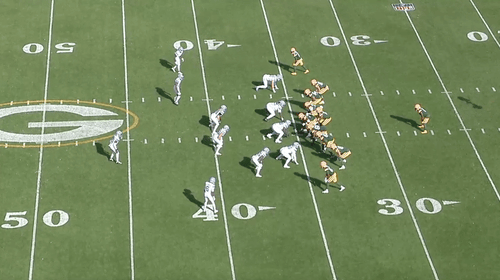The new Packers can close games
Even in limited snaps, Micah Parsons made his presence felt for the Packers defense. The unit still has its warts, but it can finally get stops against premier opponents.
Good morning!
The Green Bay Packers ended the Detroit Lions' three-year win streak at Lambeau Field, blowing out the reigning NFC North champions 27-13. The visiting Lions never really sniffed the lead after the first quarter, failing to reach the end zone until they scored a garbage-time touchdown with less than a minute left in regulation.
Today's edition of The Leap explains why this season's Lions-Packers contest unfolded so differently than those in the recent past, examines the passing game, and highlights a situation to monitor during the upcoming week.
Thank you for reading and supporting our coverage. You can also support our work by following us on social media:
Jason B. Hirschhorn: @by_JBH on Twitter / @byjbh@bsky.social on Bluesky / @by_jbh on Threads
Peter Bukowski: @Peter_Bukowski on Twitter / @peterbukowski@bsky.social on Bluesky / @peter_bukowski on Threads
The Leap: @TheLeapGB on Twitter / @theleap.bsky.social on Bluesky / The Leap's YouTube channel
If you appreciate thoughtful, independent coverage of the Packers and NFL, please consider becoming a paid subscriber. Your support allows us to serve this community with the stories and reporting it deserves.
As always, thanks for making The Leap a part of your day.
In Micah Parsons, the Packers finally have their defensive closer
Jason B. Hirschhorn: On the list of pieces missing from the 2024 Packers, a defensive closer ranked near the top. While Jeff Hafley's unit finished among the NFL's top 10 in most of the advanced metrics, it couldn't get a critical stop in several high-profile games against top opponents. That included Green Bay's 34-31 loss in Detroit, which saw David Montgomery grind out a fourth-down conversion to set up the game-winning field goal.
The Packers traded for Micah Parsons in large part for his ability to help tilt the field to their advantage in those high-leverage moments. However, few expected the All-Pro pass rusher to play enough snaps so soon after arriving in Green Bay to have that level of influence on the outcome.
That notion held for most of the game. Entering the fourth quarter, Parsons had played just 16 defensive snaps, according to Pro Football Focus. That roughly tracked with what history said he would handle in his first game for the Packers, especially considering down and situation. Just over two-thirds of those snaps took place on dropbacks, the area where Parsons can make the largest impact.
However, the coaches deviated from their plan for Parsons late in the game. With the Packers in position to put the Lions away, Parsons handled an additional 14 snaps in the final quarter, nearly doubling his total workload for the contest. Those plays included his first sack in Green Bay.
"It was definitely higher than we anticipated," Packers head coach Matt LaFleur said after the game of Parsons' snap count.
Parsons affected the game outside of the fourth quarter. Evan Williams' interception came on a play when Jared Goff had the All-Pro barreling down into his face. Parsons' pressures also forced incompletions and checkdowns during the first half, resulting in punts instead of extended drives. Those contributions matter even if they won't appear on a traditional box score.
"He definitely has an aura about him," LaFleur said of Parsons. "His style of play fits with our other guys, and I think all those guys are excited to play with him. And they all benefited from that."
Parsons offered more than aura on Sunday, however. He helped close the door on the Lions in the end, exactly what the Packers need from him.
Too early to make any meaningful evaluations of the Packers' passing distribution
JBH: Certain corners of the NFL world -- mainly the fantasy bros. -- took notice of the Packers' pass distribution. No player on the team saw more than five targets. None recorded more than three catches or 68 yards. Jordan Love connected with 10 different teammates over the course of the game.
To many, this looked a lot like the Packers offense of the last two seasons. It had no single receiver as the fulcrum of the aerial attack. Efficient performers didn't necessarily see their usage pushed upward. The tight ends saw action, but mostly not as the primary reads. Those descriptions should sound very familiar to anyone who has closely observed Green Bay during the Love era.
That doesn't necessarily mean the Packers will take such an egalitarian approach throughout 2025, however.
Take Matthew Golden, the first-round wideout who generated no shortage of excitement over the past few months. He played only 23 offensive snaps, approximately 48% of the total. Those plays only resulted in two targets, which he turned into an 11-yard reception on third-and-6 and a 5-yard catch later in the first half. That seems like paltry usage, right?
While true from a strict output standpoint, it doesn't fully reflect how the Packers deployed Golden.
The Leap has written extensively about the core passing concepts upon which LaFleur has built his offense. One of those staples, often called "Yankee," has emerged as a go-to shot call in Green Bay. At its core, the concept features a two-route combo -- a deep crosser on one side with a post, corner, or other vertical route going over the top from the other side -- as well as play-action. When executed correctly, Yankee creates a deep-shot opportunity for an open receiver working over the middle.
The Packers ran Yankee on Sunday, and it generated their biggest gain of the day. On that play, Golden ran the deep crosser, the featured route on those calls. However, because the Lions defense gravitated toward the rookie -- linebacker Jack Campbell and safety Kerby Joseph bracketed Golden in the deep middle of the field -- it created a one-on-one matchup between Romeo Doubs and corner Terrion Arnold.
More often than not on Yankee, the ball finds the receiver running the deep crosser. This time, because of all the attention Golden garnered from Detroit, Love had no better choice but to bomb it to Doubs.
In terms of forecasting, it makes more sense to focus on the Packers' intentions with their play-calling rather than the results from a single game. That the coaching staff already trusts Golden enough to feature him in that way on Yankee suggests more productive days ahead for the young receiver.
All of which underscores the larger point here. Just because the Packers spread the ball around Sunday doesn't mean they won't have a more typical passing hierarchy at some point this season.
Quick observations and thoughts
Love's surgically repaired left thumb didn't appear to matter during the game. On handoffs to the running backs, the Packers ran as many times to the right as to the left (eight each), along with multiple attempts up the middle. The injury also didn't dissuade LaFleur from calling a QB sneak on fourth-and-1 in the fourth quarter. Perhaps Love continues to wear a wrap during practice and games for the next few weeks. But barring a setback, it shouldn't significantly impact Green Bay's offensive play-calling.
That the Packers largely kept Goff from testing the defense deep -- he attempted an astounding 30 passes with 6 or fewer air yards and only four of his 39 total throws traveled more than 15 yards -- represents a remarkable achievement. That the defense accomplished this without Nate Hobbs looks even more remarkable. Green Bay might not know yet whether Hobbs can suit up for Thursday's game, but his return to practice last week suggests he shouldn't stay on the sidelines much longer.
In a surprise twist, Javon Bullard started at safety for the Packers on Sunday instead of Evan Williams. That didn't seem to affect their overall usage, however. Williams out-snapped his fellow second-year defensive back on defense 66 to 59, and Bullard spent most of the game in the slot (41 snaps). Still, pay attention to that situation moving forward, especially after Hobbs returns to the field.
The Packers used multiple defensive linemen at nose tackle, but Colby Wooden's snaps in that role flashed the most. He played a pivotal role in several of Green Bay's big run stops, including a tackle for loss that nearly netted a safety during the fourth quarter. A former mid-round pick, Wooden has come a long way since entering the league, adding the necessary mass to survive along the interior. Now, he looks like the main replacement for Kenny Clark and T.J. Slaton in the run defense.
LaFleur didn't have a postgame update on the health of Aaron Banks or Zach Tom, and the short turnaround before Thursday's prime-time tilt with the Washington Commanders leaves little time for recovery. However, recently acquired tackle-guard combo Darian Kinnard hardly looked out of place against the Lions' talented defensive front, especially in the run game. Between him and Jordan Morgan, Green Bay should still have enough quality players to fill out the offensive line even if Banks and/or Tom don't return this week.




